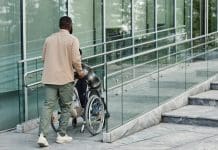Ian Streets of About Access discusses how accessibility can be improved on with implementation of some good practices
Acknowledgement that accessibility is an international issue comes with an article from the website of The Atlantic, a magazine first published in Boston in 1857.
It’s a compelling, if lengthy, read which raises some interesting questions about how to highlight good and bad practice in accessibility, and who has the right to do that.
The article by Aimi Hamraie, an Assistant Professor of Medicine, Health and Society and American Studies at Vanderbilt University, Nashville, monitors an accessibility map-athon. There is no online evidence of similar events in the UK, but it’s hard to believe they are very far away.
Looking for accessibility
Hamraie tells how a group of people – “some rolling in wheelchairs and others walking” – gather with their smartphones to meet a co-ordinator who helps them log onto a app. They then disperse to visit restaurants, cafés and shops and log any evidence that suggests disabled people are welcome.
They’re looking for parking signs, wheelchair ramps, automatic doors and accessible loos as well as the less obvious indicators, such as braille text, low-flicker lighting, glare-free floors and scent-free soap.
They log their ratings to build a database that can help others, but Hamraie warns that such apps are only as good as the data they contain. She writes: “Bad ones risk making urban life harder, rather than easier, for disabled people.
“Some are carried out by, and with, their potential users: people who are disabled and who identify a gap in more mainstream mapping technologies. Others are supported by people with relationships to disability, such as family members or therapists, and still others by philanthropic start-ups and major technology companies.”
Not just for disabilities
There is recognition that even if such a citizen does not identify as disabled, noticing and documenting the built environment can promote awareness of barriers that many people with physical, sensory, and mental disabilities face.
However there is also the “nothing about us without us” view. Hamraie notes that some map-athon participants might look for wheelchair access alone and ignore disabilities related to sight, hearing, cognition, chronic illness, learning, or chemical sensitivity.
People who primarily move by walking might not be aware of the spatial parameters needed for a wheelchair to turn inside a small space, like a bathroom. And a bathroom might be ticked as “accessible” on the basis that there are no steps, but the location of the basin, dryer and other facilities might actually render it inaccessible.
Her suggestion is that for digital-accessibility maps to work, they should be designed by “cross-disability coalitions” which are better equipped to consider the needs of all disabled people rather than those who have the same impairment. She cites the example of disabled activists who worked together to ensure that roadside kerbs had a slope which would allow wheelchair access and also incorporated yellow, tactile bumps to meet the needs of people with a visual impairment.
Digital mapping
Hamraie also recognises that while technology is global, accessibility standards are not. Guidelines which are in place in the United States do not necessarily address the realities of disability issues in other countries
Perhaps the most telling point is Hamraie’s observation that “apps can make cities more navigable, but they do not change the material features of that environment.”
Hamraie finds that the very technology which inspires the apps has a major failing, with 60 per cent of experts reporting that people with disabilities are left behind by these urban technologies.
She challenges digital mapping to do more than just record existing facilities and to drive improvements in politics, policy and design, concluding: “After all, to deserve the name, a smart city ought to be a better city, not just a more technological one.”
To read Aimi Hamraie’s article in full visit: https://www.theatlantic.com/technology/archive/2018/11/city-apps-help-and-hinder-disability/574963/?utm_source=twb
If you need help improving the accessibility of your organization or to do more by improving your skills then please get in touch and check out our website
www.aboutaccess.co.uk
















